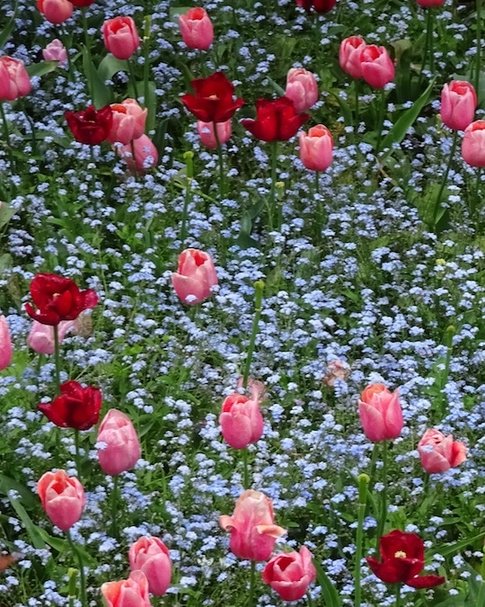|
The Photos Were Like Paintings
The envelope of clouds had broken and the sun lit upon me. I pressed into the pink plaster wall and sheltered in a strip of shade. The wall was a pleasing pink, a pale rose pink. For an hour I had been inching slowly forward toward the ticket booth. There was still a long line of people in front of me. I was tired of standing. I was hot. I was bored. Only later did I learn I had been pressing against the outer wall of Claude Monet’s house. I had long craved a pilgrimage to Monet’s gardens at Giverny. I was an American student in France in ‘74 when first I floated in his murals of water lilies that fill the walls of L’Orangerie in Paris. I had gone back through the years for other plunges into those water garden panoramas of no horizon, those planes of purple, blue, and green paint, the reflections of unseen trees on the surface of the pond. But I had never made the trek to Giverny. This time in Paris, in 2016, I was with my husband, David. A warm day in May beckoned us out of the city. I would finally weave my traveler’s dream of the gardens. But I was to be let down. We had not accounted for the three-day weekend in France and the crowds of fellow visitors who, like us, had judged the day as perfect for a visit to the magic of Giverny. Monet’s gardens—the home of the water lily pond—had begun as a simple idea: “. . . I should like to grow some flowers in order to be able to paint in bad weather as well,” he wrote his agent in 1883 not long after moving to Giverny. The gardens became his obsession, his muse. He lavished great chunks of time on plotting and planning. The pond, dug in 1893, was tended by a gardener whose only job was to maintain the lilies as Monet desired them, to remove dried leaves, fight the water rats who ate the bulbs. Monet worked and reworked the gardens to reach the reality of his vision. Then he translated that vision using paint and canvas. Often dissatisfied, he destroyed hundreds of paintings. Is this not the crux of the artist’s challenge? For vision to survive execution? The crowds of our fellow visitors at the entrance carried over into the gardens. David and I shuffled along within clots of people following the roped paths between flower beds. Keep moving. Avoid bumping other bodies. Try not to step on someone’s foot. Try not to step into someone else’s photograph (impossible!). I was always in the way of others or was ungraciously pissed off because they were in my way. I saw, yes, the pale blue forget-me-nots below tulips of cabernet red, the frilly blooms of lavender iris amid blades of green leaves, the clumps of Persian red pansies with yellow centers. Yes, I took in the heavy drape of purple wisteria hanging from the pond’s Japanese bridge, reflections of encircling willow trees, the unbloomed buds of the water lilies. But for me the gardens were fragmented and shattered by the crowds. It was as if I were seeing the broken shards of a stained glass window. We took the train back to Paris. The realm I had sought remained undreamed. Back home in Seattle I glanced at David’s computer screen one evening as he edited his photos from Giverny. I was instantly snagged. David had searched every scene for the best shot. He had reached beyond the jostle of bodies and slipped past the oppression I had felt. David has the artist’s eye and he had been in the garden of an artist. He had captured Monet’s carefully crafted layers of flowers, apple trees, pink house, and green hills. His framing, his edits nipped and cut most of the people. In his long shot of the pond the eye is pulled toward the dark green rounds of lily leaves, the surface reflections of trees, clouds, and sky, the oranges and reds of azaleas around the edges. The mind barely registers the people in coats of yellow, blue, brown, and red that speckle gaps in the foliage. David’s photos were like paintings. In them I found the Giverny I had craved. Nancy Penrose Nancy L. Penrose is a writer based in Seattle. Her essays have been published in Shenandoah: The Washington and Lee Literary Review; 1966: A Journal of Creative Nonfiction; Drash: Northwest Mosaic; the collections of Travelers’ Tales; and the anthology Burning Bright: Passager Celebrates 21 Years. Details may be found at www.plumerose.net.
2 Comments
Liisa Balzar
2/11/2017 05:21:27 pm
Beautiful pairing of words and photos! Glad you found the paintings after all!
Reply
jean Sundborg
3/21/2017 11:10:20 pm
My sister's writing and brother-in-law's photos have reminded me that Giverny is on my list. Next time in Paris.
Reply
Your comment will be posted after it is approved.
Leave a Reply. |
The Ekphrastic Review
COOKIES/PRIVACY
This site uses cookies to deliver your best navigation experience this time and next. Continuing here means you consent to cookies. Thank you. Join us on Facebook:
July 2024
|






